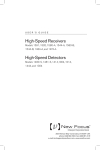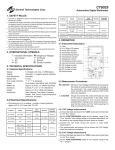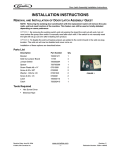Download 141,3,4,5X HSPD revD TS (Page 3)
Transcript
Models 141X, 143X, 144X & 145X F I B E R - CO U P L E D, U LT R A H I G H - S P E E D PHOTODETECTOR MODULES USER’S MANUAL TABLE OF CONTENTS HANDLING PRECAUTIONS ..............................................................3 QUICK START ........................................................................................4 INTRODUCTION ..................................................................................5 OPERATION ..........................................................................................6 APPENDIX 1: USING AN OPTICAL FIBER ..................................10 APPENDIX 2: USING THE CORRECT MICROWAVE CONNECTOR..................................11 APPENDIX 3: INSIDE THE PHOTODETECTOR MODULE ......12 TROUBLESHOOTING........................................................................13 DETECTOR CHARACTERISTICS ....................................................16 WARRANTY, SERVICE & SUPPORT ..............................................18 141522 Rev.D Is a registered trademark of New Focus, Inc. 2 HANDLING PRECAUTIONS The detector is sensitive to electrostatic discharges and could be permanently damaged if subjected even to small discharges. Prior to handling, or making connections, be sure to ground yourself adequately. A ground strap provides the most effective grounding and minimizes the likelihood of electrostatic discharge. Do not over-torque the microwave K-connector. Excessive torque can damage connectors. Make sure the optical connector is clean and undamaged before connecting to the detector module. QUICK START The Models 141X and 144X are high-speed InGaAs photodetector modules for detection of light of wavelengths 950 to 1650 nm. The 143X and 145X are high-speed InGaAs photodetector modules for detection of light of wavelengths 400 to 1650 nm. All the models are 50-Ω terminated. An internal battery and bias circuitry make the modules self-contained so that no additional power supplies or bias circuitry are needed. To operate the modules, follow these instructions: 1. Take proper precautions to avoid electrostatic damage to the photodiode. (See the Handling Precautions above) 2. Remove module from its case. 3. Turn on power using the “Off/On” switch. 3 QUICK START (Perform steps 4, 5 and 6 if using the detector for the first time or you wish to check the battery and DC offset.) 4. Connect a voltmeter to the “Bias Monitor” SMA connector. 5. Press “Batt Chk” button. The voltage should be at least 3.5 V. 6. Release the “Batt Chk” button. Without an optical input, the voltage should be less than 10 mV. 7. Connect the photodetector module to your measurement instrument, being careful not to over-torque the K-connector. The instrument must have a 50-Ω input impedance. 8. Check that the optical power emerging from your fiber is below the Max. Pulse Power or cw Saturation Power as appropriate (see the Detector Characteristics section of this manual) to ensure detector linearity and to avoid detector damage. 9. Connect your optical fiber to the connector on the detector module. 10.When finished using the module, turn off power to preserve battery life. If any of these steps present problems or you would like more information, please consult the remainder of this manual. 4 INTRODUCTION Ultrahigh-speed measurements are easy with the Models 141X, 143X, 144X and 145X high-speed photodetector modules. These modules convert your optical signals to electronic signals, in effect, giving every high-speed/high-frequency instrument in your lab an optical input. The modules are connected directly to the test instrument or amplifier, eliminating the need for coaxial cables following the photodetector which can seriously distort picosecond pulses and attenuate microwave signals. The optical signal is delivered to the Schottky photodiode in the module through a single-mode or multi-mode optical fiber. Moreover, the photodiode bias circuit and battery are self-contained, eliminating the hassle of external power supplies and expensive bias networks and reducing the possibility of photodiode damage due to overvoltage. New Focus offers a total of eight models, allowing you to match your wavelength of interest and the connector style of your instrumentation. The Models 141X and 144X are high-speed InGaAs photodetector modules for detection of light of wavelengths 950 to 1650 nm, and the Models 143X and 145X are also high-speed InGaAs photodetectors designed for 400-1650 nm operation . Models 141X and 143X are optimized for a flat frequency response, and the Models 144X and 145X are optimized to achieve an impulse response with minimal ringing. All models are 50-Ω terminated to reduce reflections in 50-Ω systems and to make them compatible with 50-Ω receiver filters. All detectors have singlemode FC or ST fiber connectors, and an option (-50) is available for a 50 µm core multimode fiber input. Each models‘ characteristics are listed and their responsivity-vs.-wavelength curves are shown in the Detector Characteristics section of this manual. 5 OPERATION Checking the battery and offset voltage: The battery and offset voltage should be checked regularly to ensure proper functioning of the detector. 1. Turn on the module using the power switch. 2. Connect the “Bias Monitor” port to a voltmeter. 3. Press and hold the “Batt Chk” button and observe the bias monitor output. The photodiode bias voltage is momentarily applied to the “Bias Monitor” SMA connector. A reading of 5 V on this connector is typical with a new battery; the battery should be replaced when the voltage reaches 3.5 V. 4. Release the “Batt Chk” button and observe the voltage level on the voltmeter. Without an optical input, this voltage is the DC offset plus dark current. This “dark voltage” should be less than 10 mV. 5. If needed, keep the voltmeter connected to the module to optimize coupling to the fiber. Making the Microwave Connection Connect the microwave output connector of the photodetector module to a 50-Ω input test instrument such as an oscilloscope or spectrum analyzer, or other 50-Ω load using the proper torque. To avoid connector damage and signal distortion, be sure that the instrument you intend to connect to the module has a compatible connector. See Appendix 2: Using the Correct Microwave Connector for a list of connector compatibilities. Aligning the Photodetector to the Optical Input: To avoid signal distortion, the optical fiber used to deliver the optical signal to the photodetector module should be single mode at the operating wavelength and the cable length should be no longer than necessary. 6 OPERATION 1. If you do not currently have an ST- or FC-terminated optical fiber, use either a pigtail assembly or a fiber collimator (see Table 1), and align the fiber so that light exits the output fiber connector. With a pigtail assembly, use a fiber aligner such as the Model 9091 and its accessories; with a collimator, use the Model 9854 Opti-Claw or the Model 9016 tiny fiber positioner. 2. Measure the power in the fiber prior to connection to the module to be sure it is within the safe operating range (see the Detector Characteristics section of this manual). The Models 20X1-FC and 20X1-ST are useful for this purpose and have the sensitivity to aid in fiber alignment. 3. Connect the fiber-optic cable to the fiber-optic input on the detector module. The Bias Monitor may be used to optimize coupling to the fiber. 7 OPERATION Table 1. Fiber-optic cable assembly selection table. Optical Input Fiber Assembly Required < 2 mm diameter collimated beam at: 830 nm wavelength Model 1233 collimator-FC (2 meters) for 1434,1454 1.3 µm wavelength Model 1237 collimator-FC (2 meters) for 1414,1444 1.55 µm wavelength Model 1238 collimator-FC (2 meters) for 1414,1444 Other wavelengths and beam types 600 to 900 nm wavelength Model 1223 pigtail-FC assembly (2 meters) for 1434,1454 1.1 to 1.6 µm wavelength Model 1232 pigtail-FC assembly (2 meters) for 1414,1444 Patch Cable 1.1 to 1.6 µm wavelength Model 1222 ST-FC (2 meters) These assemblies are available from New Focus. Collimators require an Opti-Claw tilt-mount such as the Model 9854. Pigtail assemblies require a fiber aligner such as the Model 9091. 8 APPENDICES Replacing the battery: 1. Turn off the module and remove the two screws on the back panel with a Phillips screwdriver. (See Fig. 1.) 2. Remove the back panel and replace the battery. 3. Replace the back panel. 4. Check the battery level as described above. Fig. 1. Front, side, and rear views of the Models 141X, 143X, 144X and 145X fiber-coupled photodetector modules. Battery Check Button. When depressed, bias voltage is applied to bias monitor port Bias monitor port. Output is equal to photodiode current times 1000 ohms, for one millivolt per microamp 2.25 (57.1) Output K-connector 2.00 (50.8) Power Switch 2.00 (50.8) 3.27 (82.9) Shown with ST connector for optic input 1411 ST connector 1414 FC connector 1431 ST connector 1434 FC connector 1441 ST connector 1444 FC connector 1451 ST connector 1454 FC connector 9 Remove two screws to replace 9V battery APPENDICES APPENDIX 1: USING AN OPTICAL FIBER Single mode optical fiber can provide low loss and low distortion if attention is paid to a few important details. First, if more than one mode is allowed to propagate in a step-index fiber, the bandwidth will be degraded to approximately ƒ3-dB = [cn] / [2L(NA)2], where c is the speed of light in free space, n is the index of the core, L is the length of the fiber, and NA is the numerical aperture of the fiber. Modal distortion can be eliminated by using a fiber with a core small enough that only a single mode will propagate. In this case, the bandwidth of the fiber will be limited by material dispersion which is a property of the glass used in the fiber core. In this limit, the bandwidth is approximately* ƒ3-dB = 1 / [2LM∆λ], where L is the fiber length in kilometers, M is the material dispersion in ps/(nm × km), and ∆λ is the line width of the optical source in nm. This bandwidth limitation can be ignored for glass fibers less than 10 meters in length, but can be serious for longer fibers and spectrally broad sources. *Palais, C.J., Fiber Optic Communications, Prentice-Hall, Inc., Englewood Cliffs, NY., 1984 10 APPENDICES APPENDIX 2: USING THE CORRECT MICROWAVE CONNECTOR The performance you obtain from the Model 14XX photodetector modules will depend largely on the instrument you use to measure its microwave output and how the connection is made to this instrument. The male connector of the photodetector module should be connected directly to the female connector of the instrument. If an intervening coaxial cable is used, care must be exercised in selecting a cable that has sufficiently low loss in the frequency range of interest. Even if a coaxial cable is not used, performance can be degraded if an improper adapter is chosen for mating to the instrument. Common SMA connectors, for example, are intended for use to only 18 GHz. Table 2 is a list of a few connectors and the frequency range in which they may be used. Table 2. Common RF connectors and the corresponding frequency ranges in which they are useful. Connector Type Frequency Range Compatibility BNC DC-2 GHz — SMA DC-18 GHz Wiltron K, 3.5 mm 3.5 mm DC-34 GHz SMA, Wiltron K Wiltron K DC-40 GHz SMA, 3.5 mm 2.4 mm DC-55 GHz Wiltron V Wiltron V DC-65 GHz 2.4 mm New Focus also offers the following products: Model 1224 Female-V to Male-K Model 1225 Male-SMA to Female-BNC Model 1226 Female-SMA to Male-BNC Model 1227 40-GHz Flex Cable, Female-K to Male-K 11 APPENDICES APPENDIX 3: INSIDE THE PHOTODETECTOR MODULE Inside the photodetector module is a gold-plated microwave housing that contains the high-frequency circuitry. This housing is bolted to a printed-circuit board which regulates the bias for the photodiode and amplifies the DC photocurrent for the monitor port. The optical signal is brought from the front-panel connector to the microwave housing with a 0.2-meter, 9-µm core fiber. Although the material and modal dispersion per unit length of this fiber can be high at certain wavelengths, there is no degradation in frequency response since the fiber is only 0.2 meters long. The fiber is protected by a sheet metal flange to prevent damage while changing the battery. A simplified schematic is provided in Fig. 2 for your reference. Fig. 2. Simplified schematic diagram of the 141X, 143X, 144X, and 145X series photodetector modules. Microwave Output Connector Microwave Housing – Photodiode + V – Bias Monitor V Batt Chk + + V + V - V + V V - On/Off - 12 TROUBLESHOOTING Several problems which can arise with the detector modules and procedures to check for them are outlined below. Problems: Damaged photodiode/Excessive offset voltage: The photodiode can be damaged by electrostatic discharge or excessive optical power, and both causes lead to an increased dark (or offset) voltage. A damaged photodiode can result in a degraded responsivity and frequency/impulse response. See DC Offset Voltage below. Low bias voltage: If the photodiode bias voltage is too low, the frequency/impulse response of the detector will degrade, as will the responsivity. See Checking the Battery below. Dirty fiber-optic connector: A dirty fiber-optic connector can cause an apparent degradation of responsivity. See Basic Optical Test below. Tests Procedures and Solutions: DC Offset Voltage With no light on the photodetector, turn the detector on and use a voltmeter to measure the Bias Monitor output voltage. This voltage is the DC offset plus dark current. If the output is >10 mV, then the detector is probably damaged and will need to be returned to New Focus. Checking the Battery 1. Turn on the module using the power switch. 2. Connect the “Bias Monitor” port to a voltmeter. 3. Press and hold the “Batt Chk” button and observe the bias monitor output. The photodiode bias voltage is momentarily applied to the “Bias Monitor” SMA connector. A reading of 5 V on this connector is typical with a new battery; the battery should be replaced when the voltage reaches 3.5 V. 13 TROUBLESHOOTING Replacing the Battery 1. Turn off the module and remove the two screws on the back panel with a Phillips screwdriver. (See Fig. 1.) 2. Remove the back panel and replace the battery. 3. Replace the back panel. 4. Check the battery level as described above. Basic Optical Test To quickly test whether a photodetector appears to be working, you can perform a simple DC optical test: 1. Turn the detector on. 2. Using a voltmeter or oscilloscope, measure the output voltage from the Bias Monitor on the front panel. (With no light on the detector, the Bias Monitor voltage should be <10 mV.) 3. Couple some CW light into the photodetector. 4. With the voltmeter or oscilloscope, you should observe a DC output voltage. If you know the optical power and wavelength, you can calculate the expected output voltage (Vout) using the expression: Vout = Pin • R • G, where Pin is the input optical power (watts), R is the photodetector’s responsivity (A/W), and G is the amplifier’s transimpedance gain (V/A). The gain of the bias monitor port is 1000 V/A. If the output voltage appears to be low, then the fiber connector might be dirty. If a dirty connector is suspected, see Cleaning the Fiber Connector below. Cleaning the Fiber Connector The high-speed photodetectors have an internal fiber connector and a fiber pigtail that brings the input light to the detector. If the fiber connector is dirty, this can block the input light so that light 14 TROUBLESHOOTING sent into the detector will produce little or no output voltage. Note also that if the fiber types are not compatible (single-mode with multi-mode, and vice-versa), this can also be the cause of a very low output voltage. To clean the fiber: 1. Turn off the module. 2. Blow filtered air or another inert gas (such as nitrogen) into the input fiber connector. This will help to remove any dust or dirt particles that might be blocking the input light. If more cleaning is needed, proceed with steps 3-8. 3. Wear a grounding strap. 4. Remove the two screws on the back panel with a Phillips screwdriver. Remove the back panel. 5. Remove the two screws on the bottom of the detector using an Allen key (1/16” or 1.5-mm), and carefully slide the detector housing off. Steps 6-8: Be extremely careful not to pull on the fiber. Stress applied to the fiber where it attaches to the microwave housing can cause the fiber to misalign from the photodiode, resulting in degraded detector performance. 6. Carefully disconnect the fiber connector from the fiber receptacle attached to the front panel of the detector. 7. The front surface of the fiber can be cleaned using acetone or alcohol and lens tissue. 8. Carefully reconnect the fiber to the front panel receptacle, re-install the detector housing (be careful not to pinch or damage the fiber), and re-install the back panel. 15 DETECTOR CHARACTERISTICS Model # 1411(1414) 1431(1434) 1441(1444) 1451(1454) Wavelength Range (multimode versions) 950-1650 nm 950-1650 nm 400-1650 nm 550-1330 nm 950-1650 nm 950-1650 nm 400-1650 nm 550-1330 nm Max. Full Width at Half Maximum • • 18.5 ps 18.5 ps Min. 3-dB Bandwidth (Electrical) 25 GHz 25 GHz • • Conversion Gain at Peak λ 15 V/W 5 V/W 15 V/W 5 V/W Responsivity at Peak λ 0.6 A/W 0.2 A/W 0.6 A/W 0.2 A/W Output Impedance 50 Ω 50 Ω 50 Ω 50 Ω Min. NEP 30 pW/√Hz 90 pW/√Hz 30 pW/√Hz 90 pW/√Hz cw Saturation Power 2 mW 10 mW 2 mW 10 mW Max. Pulse Power 100 mW 200 mW 100 mW 200 mW Detector Material InGaAs InGaAs InGaAs InGaAs Detector Type Schottky Schottky Schottky Schottky Detector Diameter 25 µm 25 µm 25 µm 25 µm Power Requirements 9-V battery 9-V battery 9-V battery 9-V battery Optical Input* ST(FC) ST(FC) ST(FC) ST(FC) Electrical Output Wiltron K Wiltron K Wiltron K Wiltron K *Single mode. Specify the -50 option for a 50 micron core multimode fiber. Bias Monitor: 16 DC Gain 1 mV/µA 1 mV/µA 1 mV/µA 1 mV/µA DC Offset <10 mV <10 mV <10 mV <10 mV Output Impedance 1 kΩ 1 kΩ 1 kΩ 1 kΩ Bandwidth 50 kHz 50 kHz 50 kHz 50 kHz DETECTOR CHARACTERISTICS Fig 3. Responsivity vs. wavelength for a) Models 143X and145X and b) Models 141X and 144X. Responsivity increases from 0–0.52 A/W over the range of 950–970 nm. Responsivity, A/W 0.6 0.4 b 0.2 a 0.0 300 500 700 900 1100 1300 1500 1700 Wavelength, nm 17 WARRANTY, SERVICE & SUPPORT New Focus, Inc. guarantees its products to be free of defects for one year from the date of shipment. This is in lieu of all other guarantees, expressed or implied, and does not cover incidental or consequential loss. TECHNICAL SUPPORT Information and advice about the operation of your New Focus products is available from our technical support engineers. Engineers are on duty from 8:00–5:00 PST, Monday through Friday (excluding holidays). For quickest response, ask for “Technical Support” and know the model number for your product. Phone: (408) 980-8088 Fax: (408) 980-8883 Support is also available by email. Email: [email protected] We typically respond to email within one business day. SERVICE In the event that your translation stage malfunctions or becomes damaged, please contact New Focus for a return authorization number and instructions on shipping the unit back for evaluation and repair. 18

































